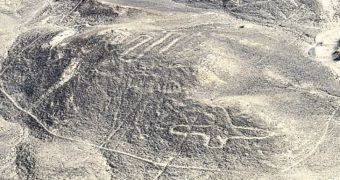Not too long ago, several previously undocumented geoglyphs were discovered in the Nazca Desert in Southern Peru. The geoglyphs likely emerged from under the soil that covered them for hundreds of years after a series of sandstorms hit the region.
Geoglyphs are large designs or motifs that are created on the ground and that are best observed from above. In order to count as geoglyphs, such designs and motifs must measure at least 4 meters (3.3 feet) in length.
Information shared with the public says that the previously undocumented geoglyphs in Peru's Nazca Desert were discovered by a pilot named Eduardo Herrán Gómez de la Torre, who was simply flying over the region when he chanced to see them.
According to Phys Org, the designs and motifs identified by pilot Eduardo Herrán Gómez de la Torre include a snake, a bird, a camelid believed to be a llama, and a series of zig-zag lines. Of these geoglyohs, the one showing the snake is about 59 meters (196 feet) long.
Shortly after laying eyes on these geoglyphs, pilot Eduardo Herrán Gómez de la Torre contacted archaeologists and historians, and told them all about his find. It is expected that researchers will soon report to the area to further examine them.
The newly discovered geoglyphs, which sit on nearby hills not far from the desert floor, are believed to have been created by ancient Nazca people sometime between 500BC and 500AD. They are not the first designs and motifs of this kind to have until now been found in this part of the world.
Thus, researchers say that, over the past decades, about 700 figures like the ones pictured next to this article have been discovered in Peru's Nazca Desert. Of these, some show animals such as birds and snakes, and other natural objects. Others comprise lines that make up various geometric figures.
Scientists are yet to figure out why it was that people who lived in this part of the world hundreds of years ago saw fit to create these figures. What is known is that the geoglyphs were created by getting rid of iron-oxide coated pellets to a depth of 4 to 6 inches (10 to 15 centimeters), and that they comprise a single line that never crosses itself.
This is yet to be confirmed, but researchers suspect that the geoglyhs in Peru's Nazca Desert were created for religious purposes. Interestingly enough, some of the figures adorning the ground in this remote corner of the world have also been identified on bits and pieces of pottery dating back to ancient times.

 14 DAY TRIAL //
14 DAY TRIAL //